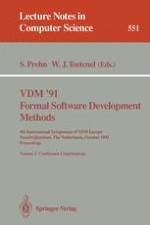The proceedings of the fourth Vienna Development Method Symposium, VDM'91, are published here in two volumes. Previous VDM symposia were held in 1987 (LNCS 252), 1988 (LNCS 328), and 1990 (LNCS 428). The VDM symposia have been organized by VDM Europe, formed in 1985 as an advisory board sponsored by the Commission of the European Communities. The VDM Europe working group consisted of researchers, software engineers, and programmers, allinterested in promoting the industrial usage of formal methods for software development. The fourth VDM symposium presented not only VDM but also a large number of other methods for formal software development. Volume 1 contains conference contributions. It has four parts: contributions of invited speakers, papers, project reports, and tools demonstration abstracts. The emphasis is on methods and calculi for development, verification and verification tools support, experiences from doing developments, and the associated theoretical problems. Volume 2 contains four introductory tutorials (on LARCH, Refinement Calculus, VDM, and RAISE) and four advanced tutorials (on ABEL, PROSPECTRA, The B Method, and The Stack). They present a comprehensive account of the state of theart.
